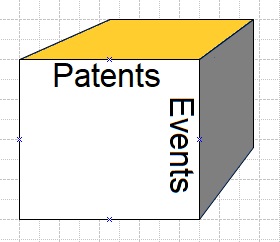The patent offices of the United States and Canada have changed their fees. Now is a good time to consider what you spend on patents, how to classify the expenses, how to budget, and how the changes could affect you. Read on to learn about useful ways to classify your expenses (e.g., AFee, OFee, MFee) and use event-based budgeting.
News on fee changes
The Canadian Intellectual Property Office (CIPO) has increased many fees have changed as of January 1st. Most fees are up only about 3%. Expect a larger increase in 2024.
The United States Patent and Trademark Office (USPTO) has kept most fees unchanged but reduced fees for Small and Micro entities. These classes of applicants and patentees get a discount from the regular rates. A small entity previously got a 50 percent discount now gets a 75 percent discount. A micro entity moves from 60 percent to 80 percent. The USPTO fee schedule has been updated to reflect these changes.
Think about how the fee changes could affect you
If you own Canadian patent applications or patents you may want to pay some fees in advance during 2023 before the large fee increase in 2024. However, note the definition of a small entity in Canada is changing. So talk to us if you have any questions about reducing your spend for 2024.
You might have questions about who qualifies for the small entity status in Canada, or as a small or micro entity in the United States. For more information on the definitions see the following table of links. Please note that the systems are complicated with definitions, exceptions, and carveouts to the exceptions.
| Small | Micro | |
| Canada | Definition at s. 44(s) & explanatory note | Not available |
| United States | MPEP §509.2 | MPEP §509.3 |
You might be affected by the future changes in the definition of a small entity in Canada. For more information see Canada, 2022 “Rules Amending the Patent Rules” Canada Gazette.
Talk to Perpetual Motion Patents to see what discount you qualify for and the risks associated with using that discount. These discounts are like a house of cards.

Creating your patent budget
You should revisit what you spend on patents once every year or every other year. We have some tips on how you can classify your patent expenses and an advanced way to budget.
Split your patent costs into three types
Split the fees you pay by type and use these classifications to better track and plan. We suggest the following:
- AFee – Agent or attorney Fees: money paid to specialist advisors.
- OFee – Official Fee: What the government charges in application and grant process.
- MFee – Maintenance Fee: What the government charges to maintain your IP application or right.
The mix of these fees changes over the lifecycle of a patent. Initially the Afees dominate, then OFees rise up, and finally the MFees the largest ongoing spend.
AFees – early costs
The money paid to specialist advisors an important cost to track. These are variable costs. Basically, per patent file you want to know what you spent on drafting and prosecuting the application. This expense could include fees to your patent agent, for a drafts person, or for translation. If you have your AFees by file (e.g., patent or application) by year you have a good idea of how to forecast costs on further filings.
OFees – helpful to track
There are many official fees in securing your patent. These fixed costs include:
- Filing fee
- Search fee
- Examination fee
- Request for continued examination
- Issue fee
Generally, these fees are modest but grow if your application has a complicated ride through the patent office. Note in the United States the pattern is normally a first non-final office action and then a final office action after which you may need to pay a request for continued examination (RCE) if you want to continue. In Canada the RCE system is new and the number of non-final office actions isn’t well-defined.
Coding these OFees separately from AFees helps you compare patent offices and agents.
MFees – Important later costs
Maintenance fees are like renewing a lease and paying further rent on a property. You do this to keep your patents in force. In the US there are three (3) payments after your patent issues. In other patent offices (e.g., Canada, Europe) these fees are needed annually even when your application is pending. Hence these fees are sometimes called annuities. There is no fee for PCT applications.
Once the USPTO grants your patent you must pay recurring and increasing fees at 3.5, 7.5, and 11.5 years after the issue date. You can pay the fee up to six (6) months early, or with a surcharge, up to six (6) months late. The fee amount increases with time and there are discounts for small and micro entities. The fee at 11.5 years is nearly four times that at 3.5 years and this is designed to make you think about renewing. For more information see the USPTO Fee Schedule.
You have the option to let patents lapse by not paying the fees. You can do this to save money, reinvest in new patents, or expressly dedicate a patent to the public. For many industries, the 11.5 payment should be made after serious consideration.
The Canadian system is different. Fees are needed on the application and on the patent. They are due yearly starting on the second anniversary of the filing. The fee amounts change in steps with the anniversary and over time with inflation. For a patent they can be paid by anyone and for an application, they must be paid by your appointed patent agent. There are discounts for small entities (50 people or fewer) but making such payments comes with risks. For more information see Pay patent maintenance fees.
A good practice for Canadian applications is asking your Canadian patent agent to pay for two years at a time. Their fee for doing so remains fixed, you save yourself future work, etc. For issued patents, you should hire an annuities provider and instruct them yearly.
Event-based costing
If you track your costs by type and year you already will have a good picture of your patent spend. However, there is one missing element – tracking events.

The basics of event-based tracking
Track the events associated with your patent files to better understand the change in costs throughout the patent lifecycle. But classify these so you can do meaningful filtering and analysis. Broad categories of events are:
- Provisional
- Filed
- Prosecution
- Grant
- Post-grant
- Maintenance
So, for example, you have records showing: date, year, event type, category of event, costs, and cost type. Now you can analyze year, category of event, and cost type. You can aggregate costs or counts. A provisional patent filing thus could look like:
| File | Date | Year | Event | Category of Event | Fee type | Amount |
| CLNT07US01P | 2023-01-31 | 2023 | Prov Filed | Provisional | OFee | 300 |
| CLNT07US01P | 2023-01-31 | 2023 | Prov Filed | Provisional | AFee | 9,250 |
Note the data has high redundancy by design. Those familiar with the following technologies will recognize this approach: Activity Based Costing (ABC), Data Warehousing with a Star Schema, Event Storming, and Online Analytical Processing (OLAP). The basic idea is you look at subjects and events in your domain. Disaggregate your data into records that link to useful classifications – date, file, category. You build these records over time. At any point you can filter, sort, and aggregate data. If you reduce redundancy in the records, they become more readable, but you likely can’t answer basic questions because you can’t disaggregate on the fly. If you doubt the power of this approach look no further than Visier, a Vancouver based software company, that delights its customers and is worth over a billion dollars using OLAP and event-based modelling to provide people analytics.
With systems like these it is possible to get per year the number of occurrences of an event and the associated costs. You then can estimate costs for upcoming year for the event type and sum up over all event types. For example, a small patent portfolio may have dozens of prosecution events. You then have an AFee and Ofee value for the type of event and year. You know the average cost per event. With your estimate on the number of similar events for the next year, you have a good starting point for your budget. If the OFees have increased then you can update your projections.
Discussion
What a patent costs is an important question. Breaking down the costs into files, categories, and time helps you understand where the money is going and budget for up coming costs.
The system does have some burden. It does require data input. All systems do. One way to address this is is to start tracking in detail now and not worrying about historic data. Another issue is you need to create a tracking number system for all your patent files. We are happy to suggest a numbering system that fits your needs.
This event-based approach works. It shows your finance partners you are being principled with money. You can implement it in a spreadsheet to start. It allows you to answer many different questions under many different levels of detail. And importantly, it is very flexible. For example, you can use the same system for other IP rights. Especially, trademarks. As new expenses arise you can fit them into existing categories. For example, if you need to translate your patents you can call the translation cost an AFee.
Conclusion
We have extensive experience as in-house IP managers. We recommend you consider these three ways to handle the fee changes.
- Think about how the fee changes could affect you.
- Split your patent costs into three types: AFee, OFee, and MFee.
- Use an event-based costing with classification to track costs and estimate future spending.
If you would like help implementing any of these please do contact us.
Image credits:
- Balloon inflation — Sean Robertson
- House of cards — Sigmund



